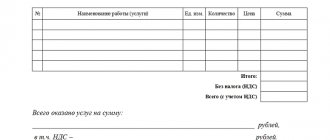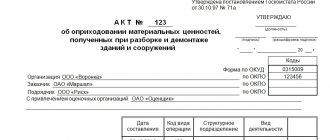The formation of shipping documents for primary documentation is an important stage in commodity-money relations. An agreement and an act of acceptance and transfer are not all that is required when transferring property assets from one person to another (under Article 223 of the Civil Code of the Russian Federation). During the signing of agreements, the participants have the right to determine how, where and to whom the transfer of property will be carried out. A third party may also participate in this process as an intermediate link, transferring objects to the final point (the buyer). All legal entities or individuals participating in the transaction must receive official papers to deliver the cargo and carry out its shipment on the spot. The absence of one of them may be detrimental to one of the parties when controversial issues arise and a claim is filed in court. Filling out such forms requires compliance with the law, since many of these forms are unified at the state level. Moreover, the principles of transfer of inventory items according to the documents discussed here are relevant both within the Russian Federation and during international transportation.
Definition
It follows from this that shipment of goods is the process of transferring manufactured products either directly to the buyer or to the carrier. It is this moment that is the cutoff after which the ownership right passes from the manufacturer (seller) to the purchaser.
This rule follows from Art. 223 of the Civil Code of the Russian Federation, however, there is a clause stating that the parties are free to agree when exactly this transition will take place. For example, at the time of transfer of goods from the carrier to the buyer in some locality, from where the buyer will deliver the goods to his warehouse using his own transport. Or the carrier will deliver it to the buyer’s warehouse, and only there the latter will become its owner.
Additional check: minimizing all possible risks
The provision of additional information by the counterparty will allow you to avoid unlikely, but extremely unpleasant consequences and simplify the pre-contractual verification. This includes the documents necessary to conclude an agreement with the LLC, which are available upon request:
- a free-form certificate listing basic data (name, contact details, registration and location address, bank details and information about the director, chief accountant, representative);
- information about the owners of the legal entity, its beneficiaries and interested parties;
- confirmation of the authenticity of the signature of the person signing the papers and the director (in such cases, present a copy of the bank card with the signature on the back side).
Why is it important?
Fixing the moment of transfer of ownership is a very important point in the contract for the sale of goods. Indeed, during transportation, cargo is exposed to many different risks, such as its loss or damage, failure of individual parts, damage that negatively affects the appearance of the product.
Therefore, it is necessary to find out in advance who bears these risks, in other words, who will pay for all this. For the same reason, it is necessary to correctly prepare shipping documents. After all, only having them in hand can you count on the opportunity to prove your case in arbitration court. And, therefore, to compensate for losses that may be caused when these negative circumstances arise.
Signing and contents of the document
This waybill is signed by the baggage addressee and the road carrier, certifying with their own seals. During shipment, a note is placed on it indicating that the baggage has been accepted by the carrier, signed by the driver who accepted the baggage. The consignor, in the presence of the driver, writes down the weight and number of pieces of cargo, its condition, packaging method and sealing data in the consignment note. In addition, the period for accepting baggage for transportation is indicated.
The shipping documents include a list of all other documents accompanying the luggage: certificates, quality passports, manuals, permits, etc. For the transportation of cargo, multimodal transportation can be used, in which various types of vehicles are involved in order. From an aircraft to a dog sled. However, road transport remains the most famous. At the same time, their documentary registration creates a lot of problems for accountants. Solutions to them must be sought in the field of transport law. Meanwhile, even the agencies exercising control are unable to navigate its intricacies. This demonstrates the experience of countless official explanations.
The agreement and its subject
The first document from which relations with a counterparty begin is a supply agreement or a goods sales agreement. What is their difference? The first of them is issued when the seller himself manufactures the product, and the second when he resells it. At its core, supply is a type of purchase and sale. The differences in the preparation of documents for shipment in the first and second cases will be discussed below.
What needs to be included in the agreement in order to successfully complete and process the shipment? The first necessary condition without which in the case under consideration the contract is considered not concluded is the condition about its subject - the goods. It needs to be described in sufficient detail, since this data will definitely be needed when filling out shipping documentation, in particular for the invoice for the shipment of goods.
Summary
In this article, we examined in detail current issues regarding accompanying documentation when shipping goods:
- What documents are provided?
- Which employees need them at work,
- Why are they useful?
- What risks arise due to the lack of documents,
- What opportunities open up thanks to the presence of a complete package of documents.
We hope this information will help you avoid excesses in your work, win tenders and closely monitor the document flow during deliveries.
May 21, 2021
Product description
Its name can be indicated according to:
- All-Russian Product Classifier;
- GOST;
- technical conditions, other regulations;
- technical passport;
- certificate of conformity;
- supplier catalogs.
Another essential condition, without which it cannot be said that the contract has been concluded, is an indication of the quantity of goods. It is determined either in units of measurement or in monetary terms. In this case, the quantity of goods must be agreed upon for each item.
Commercial invoice
The invoice is one of the most important documents accompanying the cargo. Based on the information from it, the customs value is determined, and, as a result, duties, taxes and fees are calculated.
The invoice confirms the value of the declared goods, reflects the fact of the transaction between the buyer and the seller and is the basis for payment for the goods. It contains information about the parties to the transaction, the price and a complete description of the goods, terms of payment and delivery. The more detailed the invoice is, the more convenient it is for the inspector to check the entire set of documents.
For example, when importing textile products, you can indicate in the invoice the composition of the fabric, the type of weave of the threads and the packaging scheme for the goods in boxes, so as not to look for this data in the description or on the packing list.
There is no single internationally approved invoice form; this is not a strict reporting form, therefore, when drawing up this document, you need to especially carefully check the completeness of the information provided. An experienced customs broker will help you draw up an invoice at the preliminary stage of document verification in such a way that it does not raise questions from the customs inspector.
Example of an invoice issued by a Chinese supplier
Other important parameters
Although their absence in the contract does not initially indicate its invalidity as not concluded, it may subsequently, if disputes arise, become an obstacle to the presentation of evidence in the arbitration court. In some cases, the court may recognize such an agreement as not concluded.
These include instructions on:
- assortment and completeness;
- delivery time;
- price of the goods.
If this is a supply contract, then, as a rule, a specification is attached to it. This is a document that indicates the name of each product item, quantity and other characteristics.
What can happen due to lack of documentation
- Equipment downtime in emergency situations and lost profits.
- The UPD is required by the project customer. It is important for the contractor to provide reporting documents proving his costs according to the estimate. In the absence of a document, the customer cannot accept and register the purchased spare parts.
- A ban on the import of equipment to the field or to the site of construction work.
- No liability of the Supplier in the event of a warranty claim. A complete package of documents allows you to demand from the Seller fulfillment of warranty obligations or reimbursement of costs.
Basic rules of shipment
To ensure the safety and quality of the supplied goods and create conditions for its timely acceptance, it is necessary:
- Strictly comply with the rules for packaging goods, its labeling and sealing of individual places.
- Accurately determine the quantity of goods (its weight, bags, bundles, boxes, packs, bales).
- Deliver products that meet the established requirements in terms of quality and completeness.
- Clearly and correctly draw up documents certifying quality and completeness, shipping and settlement documents and check the compliance of the data specified in the documents with the actual ones.
- Transfer documents to the receiving party or send them, depending on the terms of the agreement.
- Comply with the loading and securing rules in force for transport.
Payment acceptance documents
There are several such documents, and the choice is made not at will, but depending on the working conditions.
Important! The only case when an individual entrepreneur should not give anything to the buyer when receiving funds from him is when he receives payment directly to a bank account . In this case, the buyer remains in possession of a document from the bank, which will confirm that he has made the payment.
Typically, legal entities and entrepreneurs pay each other through a bank. But settlements with buyers—individuals—must be supported by business entities with documents. This is necessary when accepting payment in cash, bank cards or electronic means of payment (Qiwi wallets, Yandex.Money and others). The document remains with the buyer and serves as confirmation of payment.
In most cases, an individual entrepreneur is deprived of the right to choose which document to draw up - everything is regulated by law. So, if an entrepreneur uses OSNO or the simplified tax system and trades at retail, then he is required to use a cash register. Accordingly, the buyer must be issued a cash receipt . If an individual entrepreneur applies UTII or buys a patent and at the same time is engaged in retail trade or works in the catering industry, the issue with the cash register is resolved as follows:
- if there are employees, CCP is mandatory from July 1, 2018 ;
- when working independently, CCP may not be used until July 1, 2021 .
As for the provision of services to the population, regardless of the availability of employees and the applied taxation system, you can work without a cash register until July 1, 2021. However, instead of a cash receipt, the buyer must be given a strictly reporting form (SSR). And always, and not just on demand. BSO can be ordered/purchased at a printing house, generated through an automated system, including online through a special service.
Attention! It is impossible to generate BSOs on a regular computer - they will not be valid.
Registration of shipment
If the goods are shipped in accordance with the delivery agreement, that is, they are manufactured by the seller himself, then the first document (if its acceptance is carried out at the seller’s warehouse) will be the Transfer and Acceptance Certificate. It certifies the quality of the goods, its characteristics, quantity corresponding to those specified in the contract, and is signed by representatives of both parties appointed by order.
The next document will be a packing list describing the packaging of the goods. It contains a list of goods, article or catalog number, gross and net weight, place number. It is included with the goods in a box or box in two copies, and the third is attached to the accompanying documents.
Next, you need to complete the following documents:
- invoice for receipt of goods in form No. TORG-12;
- invoice or universal transfer document;
- consignment note No. 1-T;
- a document certifying quality and completeness, which can be a quality certificate, certificate, technical passport;
- a receipt confirming payment for the goods.
Who takes part in transport transportation
The main two parties are the shipper and the recipient. But in order to deliver the goods to their destination, full-time drivers or transport companies are involved here. And they, in turn, are also presented with the same original documents as the parties to the transaction. The third party carrier may deliver the goods by sea, air or land. In the first two cases, delivery on your own is usually difficult in principle.
Do you want to implement Warehouse 15? Get all the necessary information from a specialist.
Thank you!
Thank you, your application has been accepted!
Nuances in paperwork
At the end of the study of the question of what is the shipment of goods, some important nuances of the preparation of shipping documentation will be given.
As a rule, the accounting department of an enterprise uses unified documents approved by Rosstat. But today there is an exception to this rule. If the manager, by order, approved his own forms for the enterprise, which contain details that meet the requirements of the Accounting Law, then they can be used.
As for payment for goods, if it is made by cash payments, it must be carried out using a cash register, otherwise it will be a violation of the law.
The delivery contract usually specifies the terms and conditions relating to the carrier. Depending on this, both the seller and the buyer can hire transport. Transportation can also be carried out by one of the partners.
In the first case, the consignment note is issued by the carrier company, with which the corresponding agreement is signed. She issues a power of attorney to her driver or forwarder to receive the cargo.
Shipping documents - what are they?
When organizing transportation, an important aspect is the formation of the necessary documentation. The main types of such papers include financial, transport and permitting. The chain of key events is as follows: the conclusion of an agreement between the two parties to the transaction, its execution (that is, delivery of the ordered item on time and to the right place). But at the arrival address it is necessary to carry out delivery and unloading actions, which also requires the availability of specific documents. According to Article 506 of the Civil Code, the supplier is obliged to ship the goods to the buyer or a third party. Therefore, signed agreements and an acceptance certificate will not be enough. Shipping documents required.
Financial papers
This includes invoices and commercial invoices. The formulation and execution of such shipping papers falls on the seller (shipper).
Comaccount or “CI”
The type of goods, their quality and quantity, as well as the unit of measurement and general prices are indicated here. The names and addresses of participants are also included here. Such documents prove that the sale and purchase has been completed. It determines the taxable amount for customs and creates receivables.
Proforma invoice
This is the so-called proforma invoice - a preliminary documented calculation of the transferred items and services provided. It is sent from the seller to the buyer according to the terms of the transaction and does not require payments. It is also used in world practice (in the exchange of goods between countries). It does not have a form standardized by law and does not contain information about prices.
Difference between platforms and commercial accounts
The first ones are usually used when the delivery itself and payment for it have not yet been made. This is not a “check” for payment, since the exporter does not enter a credit in his accounting department, and the importer does not enter a debit. But such forms describe the product and its value, which is similar to the second type of document. The latter are issued to give customs officers maximum information on applicable import duties and rights to import goods and materials abroad. They have legal legitimacy and are significant for tax accounting. Accordingly, they serve as an actual account for making payments.
Consular invoice
Consular invoice is commercial and is registered by the sender (foreign exporter) with mandatory certification from the consulate of the state where the buyer is located. The purpose of the compilation is to provide the competent government agencies in the country of arrival with data on the customs value of delivered products, as well as dumping. And thus implement currency control.
Shipping documents
Not all documentation discussed below is standard. The purpose of their compilation is to identify the product (for all product categories with their properties and number of units). This also includes information about the participants involved, the specifics of the transportation process and payment for delivery. The documentary set is assembled with adjustment for specific inventory and materials products. Additional documents are included at the request of the parties.
Check packing list
The shipment is accompanied by a Packing list, attached to the invoice. This contains the entire list of supplied goods and materials, indicating storage space for everything (boxes, crates, pallets, etc.). There is no standardized form here, so each organization develops its own. So the seller’s form may differ from the copies used by the buyer. But the second one usually accepts the paper sent to him in any form. Logistics companies also need it. It is also required by customs authorities when crossing the border.
Consignment note
Or rather, on the product itself. This means that this is TORG12 for release and transfer. Using this document, the purchaser checks the shipped products (by quantity, volume, quality, etc.) with the information contained in it. The seller and sender, in turn, take into account the property remaining in the warehouse.
Commodity transport
When the issuance of inventory items occurs through pick-up, the documentation discussed here will not be required. They are only needed during transportation to the customer. If a transport and logistics company is involved in this, then the documentary originals are provided to it. They always indicate the details of the carrier, vehicle and forwarder.
Usually delivery is made using road transport. Then two types of forms are used: 1-T and the form attached to PP No. 272 of April 15, 2011 on the rules of transportation by road (Appendix 4k). For air and railway transportation, other unified forms are used: GU-27 / GU-29-O and AWB, respectively.
Waybill
This is a T-bill (different from the TT-bill discussed earlier). It is required according to PP No. 272 dated 11. Often it is issued by the shipper (but it also happens otherwise if this is provided for in the agreements of the parties). It is usually compiled for one batch. For several, if transportation is carried out at the same time by one transport. It differs from the previous one in the absence of a product section.
What shipping documents are used to document the shipment of goods to the buyer’s warehouse using air travel? This is the so-called AWB waybill. But it only describes the property being transported, and does not legitimize this process.
Through bill of lading
Through bill of lading is required when participating in the supply of sea vessels. There may be two or more shipping lines here. That is, transshipment from one vessel to another is often carried out. The document confirms ownership of the shipped goods and materials.
Paper functionality:
- the carrier signs here for receipt of the shipment, describing the visual condition of the goods upon arrival;
- this confirms the fulfillment of the terms of the contract;
- a commodity distribution function is also performed.
Multimodal transport connaissement
In world practice, this is usually called multimodal cargo transportation by several modes of transport. Not only aquatic, but also terrestrial. That is, transportation by sea is only part of the overall journey.
International waybill
CMR is the main document for road freight delivery across the border of another state. It represents an agreement between the sender, the transport company (with ground transport) and the consignee. The CMR invoice is universal in nature, since it contains information that is understandable to a representative of any country. It confirms the legality of the transportation. In the absence of digital materials, law enforcement agencies may seize transported goods and materials. Each stage that occurs with the cargo is noted here. Whether it is transferring it to the forwarder or the final recipient. Accordingly, the financial responsibility of persons at a certain point in time is determined in this way.
Do you want to implement “Store 15”? Get all the necessary information from a specialist.
Thank you!
Thank you, your application has been accepted.
Certificate of origin
This is a document about the certification of a product, which also reflects the place of its production. The relevant government agencies enter here notes about production on the territory of a particular state. A description of product characteristics is also included. In the Russian Federation it is issued by the Chamber of Commerce and Industry. Depending on the country of purchase, the marking is affixed here. There is also a general format for some territories.
Certificate Form A
Certificate of Origin form A is a universal international document quoted in many countries. At customs it is used to identify the place of origin of the goods. The acquiring party receives benefits and bonuses during customs clearance.
Several concepts should be distinguished here:
- the country where the goods and materials were manufactured;
- preferential production - if they were produced at different foreign factories (the advantage is determined by who made the largest contribution to the cost of the products - usually more than 50%);
- delivery point means where the order was delivered to the recipient (may differ from the first two).
Destination Control Statement
The Destination control statement is made by the sender and is noted on commercial invoices, bills of lading, air waybills and other export documents. It is necessary to accompany the delivery process to the final destination. It does not have any special form and is compiled to ensure arrival at a specific geological point.
What documents are needed when shipping goods to the buyer regarding its quality?
This documentation is required not only to list the characteristics of the product, but also for reconciliation with what is actually received.
Third Party Acceptance Certificate
Some acquirers want to see a certificate of inspection by a disinterested party. The costs of such procedures are often borne by them (unless otherwise specified in the contract).
Four types of such operations:
- pre-production control to determine the quality parameters of raw materials and individual components that the manufacturer will use in the process;
- taking samples or samples from the production line (helps to find defects before shipment or before the actual receipt of defects);
- control of material assets when loading containers for delivery;
- inspection at the port upon arrival (visually and using instruments).
Certificate of testing or quality of materials
For certain product categories (chemical products and raw materials), their supplier provides chemical certificates indicating indicators of composition, acidity, viscosity, etc. This information is obtained with the assistance of an independent laboratory chosen independently by the parties (before shipment or after). Metal objects are delivered subject to certification of the properties of these materials.
General rules for creating primary documentation
What documents are needed when shipping goods for the buyer is not the only important question. It is also important to follow the principles of their completion and circulation. From the point of view of legislation, it is necessary to take into account Art. 9 Federal Law 402 on accounting from 11th year.
Here are the required sections included in the document:
- Name.
- Date of writing.
- Mention of the person who compiled the specific paper.
- The presence and nature of economic life.
- The size of natural and financial measurements (indicating measurement units).
- Listing the positions of those people who make the transaction and are responsible for its execution and correct execution.
At the end, people’s signatures are placed as standard (from the sixth point). To do this, their surnames and initials or other details identifying them are written down.









